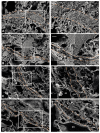Differential tissue stiffness of body column facilitates locomotion of Hydra on solid substrates
- PMID: 32958523
- PMCID: PMC7116704
- DOI: 10.1242/jeb.232702
Differential tissue stiffness of body column facilitates locomotion of Hydra on solid substrates
Abstract
The bell-shaped members of the Cnidaria typically move around by swimming, whereas the Hydra polyp can perform locomotion on solid substrates in an aquatic environment. To address the biomechanics of locomotion on rigid substrates, we studied the 'somersaulting' locomotion in Hydra We applied atomic force microscopy to measure the local mechanical properties of Hydra's body column and identified the existence of differential Young's modulus between the shoulder region versus rest of the body column at 3:1 ratio. We show that somersaulting primarily depends on differential tissue stiffness of the body column and is explained by computational models that accurately recapitulate the mechanics involved in this process. We demonstrate that perturbation of the observed stiffness variation in the body column by modulating the extracellular matrix polymerization impairs the 'somersault' movement. These results provide a mechanistic basis for the evolutionary significance of differential extracellular matrix properties and tissue stiffness.
Keywords: Atomic force microscopy; Biomechanics; Extracellular matrix; Tissue rheology.
© 2020. Published by The Company of Biologists Ltd.
Conflict of interest statement
Competing interestsThe authors declare no competing or financial interests.
Figures







References
-
- Alexander RM. Principles of Animal Locomotion. Princeton University Press; 2003.
-
- Anderson EJ, Demont ME. The mechanics of locomotion in the squid Loligo pealei: locomotory function and unsteady hydrodynamics of the jet and intramantle pressure. J Exp Biol. 2000;203:2851–2863. - PubMed
Publication types
MeSH terms
Associated data
Grants and funding
LinkOut - more resources
Full Text Sources

